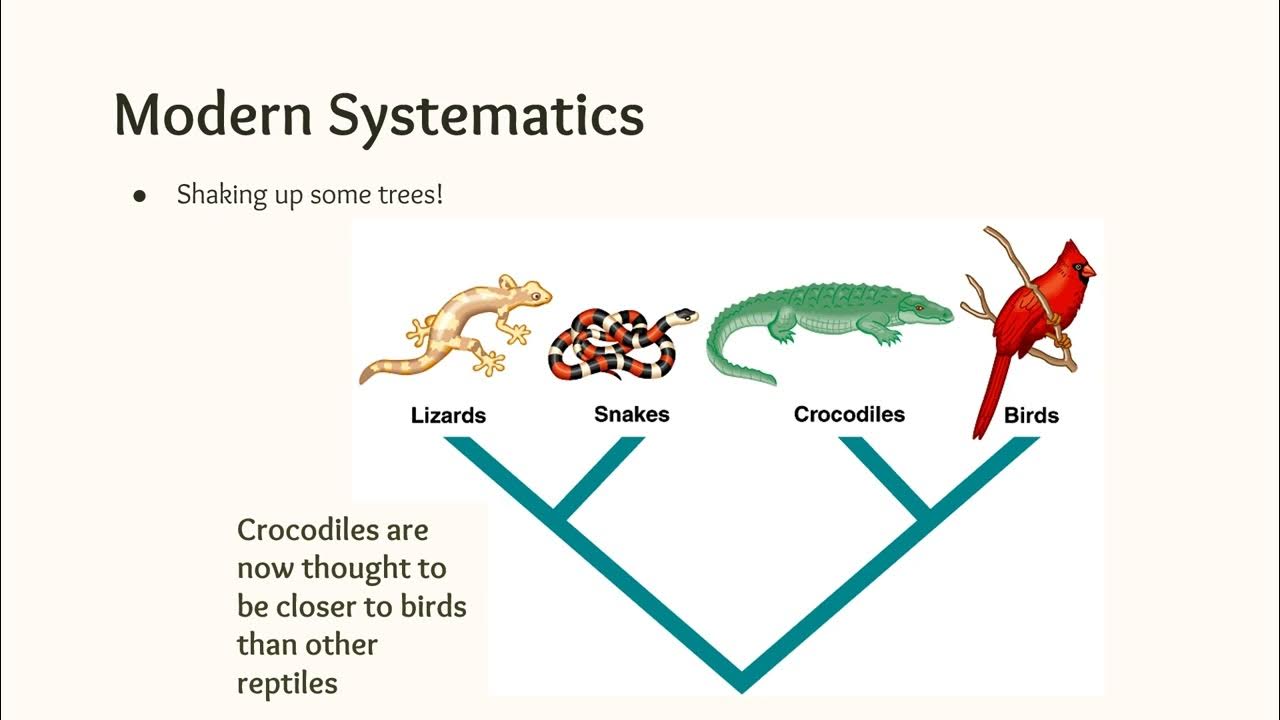The Origin of Birds — HHMI BioInteractive Video
Summary
TLDRThis script explores the evolutionary origins of birds, revealing how they descended from theropod dinosaurs. It details the discovery of fossils like Archaeopteryx and Sinosauropteryx, which provided evidence of feathers in dinosaurs, challenging the notion that feathers evolved solely for flight. The script discusses the co-option of feathers for flight and the diverse forms of dinosaurs and birds that lived together before a mass extinction event. It concludes by highlighting that birds are the avian dinosaurs that survived, continuing the legacy of their theropod ancestors.
Takeaways
- 🐟 The animal kingdom is categorized into major groups based on key traits, such as fins for fish and wings for birds.
- 🦆 The origin of birds and their features like wings and feathers has been a significant mystery in biology.
- 🕊️ Over 10,000 species of birds exist today, all with feathered wings, indicating a complex evolutionary history.
- 🔍 Scientists have used the fossil record to trace the evolution of birds from their flightless ancestors.
- 🚀 The past 30 years have seen an abundance of new fossil discoveries that have shed light on bird evolution.
- 🦴 Archaeopteryx, a 150 million-year-old fossil, provided early evidence linking birds and reptiles.
- 🦈 Pterosaurs, despite being contemporaries of birds, evolved flight independently and had different wing structures.
- 🦖 The connection between birds and dinosaurs was suggested by similarities in skeletal structures and features.
- 🦷 Discoveries like Deinonychus challenged the perception of dinosaurs as slow and cold-blooded, hinting at a warmer-blooded, fast-moving nature.
- 🦴 Theropods, a group of dinosaurs that included T-Rex, were identified as the closest relatives of birds due to shared features.
- 🪶 Feathered dinosaurs like Sinosauropteryx and Caudipteryx confirmed that feathers predate flight and may have had other functions initially.
- 🦜 The evolution of birds involved co-option, where existing structures like feathers were adapted for new uses such as flight.
- 🌟 The mass extinction event 66 million years ago wiped out many creatures, but a group of toothless birds survived and evolved into today's diverse avian species.
- 🐦 Dinosaurs are not entirely extinct; the avian dinosaurs, now known as birds, continue to thrive and adapt.
Q & A
What are the key features that distinguish birds from other animal groups?
-Birds are distinguished by having feathered wings, which are stiff yet flexible, and their ability to flap for maneuvering and defying gravity.
How has the understanding of bird evolution changed over the past 30 years?
-In the past 30 years, numerous new fossil discoveries have made the origin of birds one of the best-documented transitions in the history of life.
What was the significance of the Archaeopteryx fossil in understanding bird evolution?
-The Archaeopteryx fossil, discovered over 150 years ago, showed a mix of reptilian and bird-like features, pointing to a close link between birds and reptiles.
How do the wing structures of pterosaurs differ from those of Archaeopteryx and birds?
-Pterosaurs had wings constructed with a membrane attaching to a very long fourth digit, whereas Archaeopteryx and birds have wings with feathers attaching individually along their arm and hand bones.
What evidence led Thomas Huxley to propose that birds are related to dinosaurs?
-Huxley noted the resemblance of Archaeopteryx to a turkey-sized dinosaur called Compsognathus, which shared features like three-digit hands, hollow bones, and bipedal stance.
What discovery by John Ostrom challenged the traditional view of dinosaurs as slow and cold-blooded?
-Ostrom discovered the fossil of Deinonychus, a small, agile dinosaur with a slashing claw, indicating that not all dinosaurs were slow and suggesting they might have been warm-blooded and fast-moving.
How did the discovery of wishbones in theropod dinosaurs support the idea that birds descended from them?
-The discovery of wishbones in theropods, a feature previously only known in birds, provided further evidence of a close evolutionary relationship between theropods and birds.
What did the discovery of feathered dinosaurs in Northeast China reveal about the evolution of feathers?
-The discovery of feathered dinosaurs like Sinosauropteryx and Caudipteryx showed that feathers existed before the evolution of flight, suggesting they initially served other purposes such as insulation or communication.
What is the co-option process in evolution, and how does it relate to the development of bird wings?
-Co-option is the process where an existing structure evolves a new function. In the case of birds, their wings are modified forelimbs that were initially used for other purposes before being adapted for flight.
How did the mass extinction event 66 million years ago impact the diversity of birds and dinosaurs?
-The mass extinction event led to the death of most dinosaur species, but a small group of toothless birds survived and evolved into the 10,000 species of birds we see today, indicating that birds are a lineage of theropod dinosaurs.
Outlines

This section is available to paid users only. Please upgrade to access this part.
Upgrade NowMindmap

This section is available to paid users only. Please upgrade to access this part.
Upgrade NowKeywords

This section is available to paid users only. Please upgrade to access this part.
Upgrade NowHighlights

This section is available to paid users only. Please upgrade to access this part.
Upgrade NowTranscripts

This section is available to paid users only. Please upgrade to access this part.
Upgrade NowBrowse More Related Video

Common ancestry and evolutionary trees | Evolution | Middle school biology | Khan Academy

Demystified: Did Dinosaurs Have Feathers? | Encyclopaedia Britannica

Charles Darwin And The Tree Of Life - Sir David Attenborough

How Birds Fly? - The Dr. Binocs Show | Best Learning Videos For Kids | Peekaboo Kidz

Introduction to Biology (part 1 of 10)

Phylogeny and Cladistics
5.0 / 5 (0 votes)